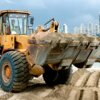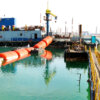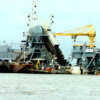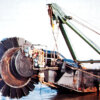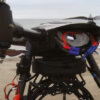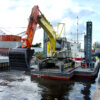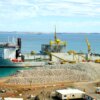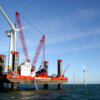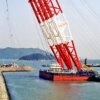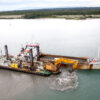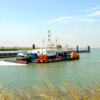Trailing suction hopper dredgers or “trailers”, are self-propelled ships with hoppers, which are storage areas in the hull for keeping dredged material.
Work method of Trailing suction hopper dredgers
Trailing suction hopper dredgers are classified as hydraulic dredgers, that is, a dredger which makes use of centrifugal pumps. They are unique in that they use their self-propulsion during excavation of sediment from a borrow area and then can transport the material to the placement area. Being self-propelled also means they can easily be mobilised to travel from project to project wherever in the world.
Drag arms
Trailing suction hopper dredgers have articulated dredging pipes, known as “drag arms”, that extend to the seabed. At the end of the drag arm, a drag head is attached. Trailers move at low speeds suctioning up the seabed material through the drag heads and pipes to the hopper.
Drag heads
The drag head can be either active or passive. A passive drag head has no additional power being applied at the head and the material to be excavated is scoured by hydraulic flow induced by the suction at the drag head. In contrast, an active drag head has power to drive cutting teeth or high-pressure water jets to excavate the material and to aid in forming the mixed solid/water slurry.
The weight of the drag arm and drag head, whether active or passive, pushes downwards thus maintaining the contact with the waterbed.
Dredge pumps
The flow generated by the dredge pumps entrains the dislodged material causing it to move and allows the material to be transported hydraulically as slurry through the suction pipes, the centrifugal pump and into the hopper. In the hopper the solids settle out and the dredged material is retained for transport and subsequent placement. Some of the finer fractions of the dredged material will overflow with the excess water from the hopper and these fines will fall back to the seabed again. Environmental restrictions may limit the amount of overflow permitted.
Dredged material placement
The dredged material is transported in the hopper to a placement site usually at a distance from the work site. The material is discharged either through doors or valves in the hopper’s bottom or, in the case of a split-hulled vessel, out of the bottom when the hull is longitudinally split.
Alternatively, material may be pumped from the hoppers through discharge pipes to shore-based placement sites with or without the use of booster pumps.
Often sediment is “rainbowed”, that is, sprayed in a high arc placing it directly onshore or at the reclamation site. Rainbowing is often the best method for discharging huge quantities of sand in shallow locations close to shore, for land reclamation projects or beach replenishment. Since rainbowing does not require floating or submerged pipelines, boosters or landlines, it is often the most economical method.
Advantages
Trailing suction hopper dredgers come in all sizes and can be used for a variety of projects. They can work in both protected and unprotected waters, where stationary equipment is more limited.
They have also the advantage of being self-propelled. This means they can work in congested areas and because they can move themselves they will cause minimum disruption to ship traffic. It also means they can travel long distances on their own to borrow areas to win sand for projects.
The largest trailers now have hopper capacities in excess of 45,000 cubic metres. Many of the larger trailers can dredge effectively at depths of up to 60 metres, using pumps mounted on the drag arm. A few are designed to dredge at depths of more than 150 metres. These economies of scale create a performance efficiency that has a direct influence on the costs of a project. Consequently, research and development on trailers is an ongoing endeavour to improve cost-effectiveness.
Types of material
Trailers are flexible in the types of material they can handle. They can dredge sands, clays, silt or gravel.
Limitations
Most trailers are not built to dredge heavy duty rock, although a few have been adapted.
Production rates
Trailers have relatively high production rates although these can vary depending on the type of material, the depth of the seabed, the distance to and from the dredge site and borrow areas, and weather conditions.
Project applications
Trailing suction hopper dredgers are used on a wide variety of maritime construction and maintenance projects. These projects include:
- maintenance dredging of ports and access channels where sand is removed to bring the waterbed to necessary depths
- beach replenishment where sand is pumped into the hopper and then placed onshore and
- capital dredging projects such as giant land reclamation projects that require millions of cubic metres of sand.
In all these examples, self-propelled trailers can remove large quantities of material, pump them into their own hoppers and transport the material sometimes over long distances to disposal areas by themselves.



